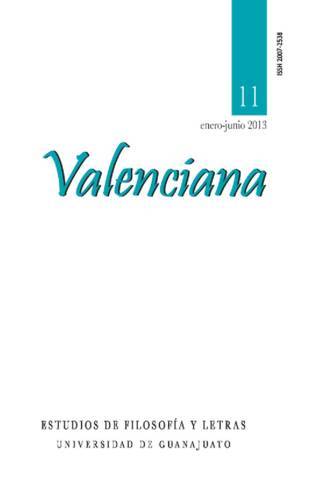La Philosophie der Arithmetik, de Edmund Husserl: sobre la fundamentación de la aritmética, del concepto de número al concepto de espacio
DOI:
https://doi.org/10.15174/rv.v0i11.21Keywords:
espacio, fenomenología, Husserl, aritmética, multiplicidadAbstract
El primer libro publicado de Edmund Husserl, Filosofía de la aritmética, contiene una serie de tesis que el fundador de la fenomenología desarrollará, con detalle, en textos posteriores, por ejemplo: Investigaciones lógicas y Lógica formal y lógica trascendental. Esto nos sugiere que el análisis sobre el concepto de número que emprende Husserl en esta primera obra, lleva implícita una investigación que está revestida de conceptos “pre-fenomenológicos”, entre los que basta mencionar el concepto de percepción. Del mismo modo, Filosofía de la aritmética se presenta como uno de los primeros intentos husserlianos por pensar filosóficamente problemas propios de la ciencia, con lo que, el texto en cuestión se reviste de un valor fundamental que vale la pena hacer explícito.References
Husserl, Edmund, 1970, Philosophie der Arithmetik. Mit ergänzenden Texten (1890-1901), [Hua XII], Hrsg. von Lothar Eley, Dordrecht / Boston / Londres, Den Haag, Martinus Nijhoff, Kluwer Academic Publisher.
_______, 1973, Ding und Raum. Vorlesungen 1907, [Hua XVI]. Hrsg. von Ulrich Claesges, Dordrecht / Boston / Londres, Den Haag, Martinus Nijhoff, Kluwer Academic Publisher.
_______, 1983, Studien zur Arithmetik und Geometrie. Texte aus dem Nachlass (1886-1901), [Hua XXI], Hrsg. von Ingeborg Strohmeyer, Dordrecht / Boston / Londres, Den Haag, Martinus Nijhoff, Kluwer Academic Publisher.
_______, 1979, Aufsätze und Rezensionen (1890-1910). Mit ergänzenden Texten, [Hua XIII], Hrsg. Von Bernhard Rang, Den Hagg / Boston / Londres, Martinus Nijhoff.
_______, 1999, Investigaciones lógicas, José Gaos y Manuel García Morente (trads.), Madrid, Alianza.
Boi, Luciano, 2004, “Questions Regarding Husserlian Geometry and Phenomenology. A Study of the Concept of Manifold and Spatial Perception”, Husserl Studies, núm. 20, Kluwer Academic Publishers, pp. 207-267.
Frege, Gottlob, 1998, Ensayos de semántica y filosofía de la lógica, Luis M. Valdés Villanueva (trad., ed. y notas), Madrid, Tecnos.
Funke, Gerhard, 1995, “La recepción de Kant en Husserl y la fundamentación de su ‘Filosofía Primera’ transcendental fenomenológica” en Anales del Seminario de Historia de la Filosofía, núm.12, Madrid, Ediciones UCM.
García-Baró, Miguel, 1993, Categorías, intencionalidad y números, Madrid, Tecnos.
Giorello, Giulio y Corrado Sinigaglia, 2007, “Space and Movement. On Husserl’s Geometry of the Visual Field”, en Luciano Boi et. al. (eds.), en Rediscovering Phenomenology. Phenomenological Essays on Mathematical Beings, Physical Reality, Perception and Consciousness, Springer, Dordrecht.
Keiichi, Noé, 1993, “Husserl and the Foundations of Geometry” en Philip Blosser et. al., Contributions to phenomenology. Japanese and Western phenomenology, Dordrecht / Boston / Londres, Kluwer Academic Publisher.
Liu, Xiaoli, 2010, “Gödel’s philosophical program and Husserl’s phenomenology”, Synthese, Springer, núm. 175, pp. 33-45.
Mohanty, J. N., 1983, Husserl and Frege (Studies in Phenomenology and Existential Philosophy), Bloomington, Indiana University Press.
Ortiz Hill, Claire y Guillermo E. Rosado Haddock, 2003, Husserl or Frege? Meaning, Objectivity, and Mathematics, Chicago, Open Court.
Tieszen, Richard, 2005, Phenomenology, Logic, and the Philosophy of Mathematics, Nueva York, Cambridge University Press.
Published
How to Cite
Issue
Section
License
Author(s) who publish in this journal do accept the next conditions:
According to copyright regulations, Valenciana does recognize and respect the authors’ moral right, as well as the right of property, which will be assigned to the journal for its diffusion in open access.
Valenciana does not charge authors for the submission, editorial process or publication in the journal.
All texts published and distributed by Valenciana (without exception) are supported by the license Creative Commons Attribution-NonCommercial 4.0 International (CC BY-NC 4.0), which allows third parties to use the publication as long as they mention the author and the first publication.
Authors can make other independent and additional contractual agreements for the non-exclusive use of his article published in Valenciana (e.g. including it in an institutional repository or in printed/electronic media), as long as it is explicitly clarified that the article was published for the first time in this journal.
For these purposes, authors must sign and send the letter of submission and copyright transfer form in a PDF file to this email address: revistavalenciana@gmail.com
This journal is under a license by Creative Commons Atribución-NoComercial-SinDerivadas 4.0 Internacional (CC BY-NC-ND 4.0)).











